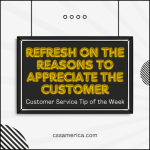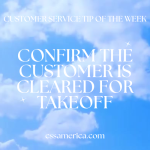
In a perfect world, you never need to say “No” to the customer. But as we all know, this is not a perfect world. There are a lot of issues in the world, and there are a lot of issues in customer service. Our companies are not perfect, our co-workers are not perfect, and our solutions to customer issues are rarely perfect.
The customer wants you to fix their issue or address their need, and often they are telling you HOW you should fix that issue or address that need. Frequently, their solutions won’t work. You can’t always waive a policy, change a process, or do something in 5 minutes that takes 5 days. You have to say No.
But there are ways to say No that are giving the right kind of No. Here are 3 quick steps to consider:
Convey Why the No: Before you say No to their solution, make sure they understand WHY their idea won’t work. In a professional way, explain the rationale so they understand it’s not a matter of you being obstinate. There’s an objectivity to your response.
Link Your Solution to Their Goal: They may suggest a certain process, but what is their goal? They may want something done, but what is their goal? They may say they want it in 5 minutes, but what is their goal? Their goal may be having a great event, getting a remedy before they hold a meeting, having a working product, getting financing for a house, or feeling better. If you can understand their desired outcome and get them to think about the goal instead of the solution, then you can link your solution to their goal.
Offer the Options: Finally, suggest alternatives that achieve their goal. Particularly if you can offer more than one solution, it gives them some control over deciding the next step. Even if there’s only one solution, by attaching it to their goal, they’re envisioning the eventual success.
Taking this approach will keep the temperature of the conversation low, put you in control, and lead to more productive and positive conversations.
Give the right kind of “No” response.
Signup for FREE Tips! Contact Us More Resources for You Visit Our Home Page














 Sometimes we communicate so well, and sometimes we don’t communicate as well as we think we do. When you’re trying to set or manage another person’s expectations, what you say may be very clear to you, but the reality is it may not be clear to the other person. And if the other person doesn’t understand what you’re conveying, they could have an expectation that’s unrealistic.
Sometimes we communicate so well, and sometimes we don’t communicate as well as we think we do. When you’re trying to set or manage another person’s expectations, what you say may be very clear to you, but the reality is it may not be clear to the other person. And if the other person doesn’t understand what you’re conveying, they could have an expectation that’s unrealistic. In Harvey Penick’s Little Red Book, the famous golf instructor provides many key tips about golf that just as well could apply to life in general. One such tip is the following: Once you address the golf ball, hitting it has got to be the most important thing in your life at that moment. Shut out all thoughts other than picking out a target and taking dead aim at it. This is a good way to calm a case of nerves.
In Harvey Penick’s Little Red Book, the famous golf instructor provides many key tips about golf that just as well could apply to life in general. One such tip is the following: Once you address the golf ball, hitting it has got to be the most important thing in your life at that moment. Shut out all thoughts other than picking out a target and taking dead aim at it. This is a good way to calm a case of nerves.






